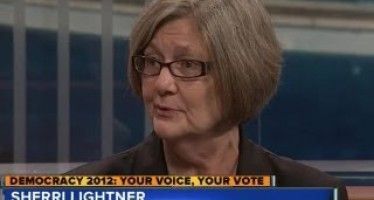The (Big) Money's On Whitman
SEPT. 17, 2010
Earlier this week, gubernatorial candidate Meg Whitman made a campaign stop at Yelp, a user-generated business review Web site. She received a bruising and biased barrage of questions from employees, critical of Whitman’s self-funded campaign financing.
It was reported this week that Whitman gave her own campaign another $15 million, making her grand total self-financed campaign contributions, $119 million. Some of the employees at Yelp appeared to have a big problem with that. They peppered her with righteous questions about using her personal wealth to fund the campaign.
Whitman’s responses were good.
The interview is here, courtesy of the San Francisco Chronicle.
One Yelp employee asked Whitman if she has “gotten her money’s worth.” Whitman said, “I believe I have, and am delighted with what we are.” Whitman told the employee audience that she’s been campaigning for two years, while Jerry Brown ran uncontested in the primary.
Whitman said she’s been to 650 events during the two years, and explained that it takes money to get out her message, as well as getting Brown’s political record out to the voter.
Another Yelp employee asked her if she would spend “whatever it takes.” And another asked Whitman if “only the wealthy can run for office.”
Whitman repeatedly referred back to Brown’s campaign, and the $28 million in campaign contributions he has received is from unions.
So while Brown has not personally financed his own campaign with his own wealth from his own bank account, Whitman said that if Brown gets elected, he will hold a meeting on day-one with the state’s unions, and start handing out the IOU’s.
Laer Pearce with The Washington Times recently reported, “Mr. Brown has a lot of money – how much exactly is not public – and unhappily for his environmentalist and global-warming-alarmist supporters, it’s oil money.”
Pearce asks, “The question here in California is: Will Jerry Brown also become more transparent and share with voters the details of this foreign influence on his personal finances?”
The frugality image that Brown emitted back in the 1970’s during his two terms as governor seems to have been nullified by his current financial holdings as well as his lovely home in one of San Francisco’s most prestigious neighborhoods. Ballotpedia reports that the original price of his home was listed at $2.68 million. Which is nice.
Where Jerry Brown lives, or the size of his bank account does not ruffle my feathers – unless the wealth is ill gotten or illegal – then it’s another story. Conservatives know that it is the wealthy who are job creators – the only true economic stimulus.
But when a candidate makes a big deal out of the legitimate wealth of an opponent, or when voters don’t hold all candidates to the same standard, feathers are ruffled.
The media, as well as liberal voters in the state are impertinent busybodies, but only with wealthy conservatives. They use blatant double standards – the liberal wealthy are off limits.
Liberals aren’t screaming at Thomas Steyer, the wealthy hedge fund manager from San Francisco, who is battling Proposition 23, and using his own money. Why the double standard? It’s legal.
What about billionaire George Soros, who has poured millions into Democratic politics in this state? How about U.S. Sen. Dianne Feinstein, whose personal wealth is vast? The founders of Google spend a great deal of money on liberal politicians and causes. Oracle’s Larry Ellison is a big liberal. California is wrought with very wealthy Democrats.
Whitman doesn’t need to compromise on her issues, nor is she beholden to any special interest group. Money and personal wealth is used on both sides of politics – the issue is where the money comes from, and the favors attached.
What the Yelp employees should have been concerned about is who the candidates will owe favors to when one of them is elected. The Yelp employees should have been outraged that public employee and labor unions are trying to put another compliant union politician in office. Remember that it is Jerry Brown who legalized public employee unions, and paved the way for Gray Davis (his Chief of Staff) to sign over the state’s checkbook to public employees. Brown is greatly responsible for the mess California is currently in, and is facing with the future unfunded public employee retirements.
At this point in the campaign, it appears that Whitman has no allegiance to anyone – including the Republican Party. Brown on the other hand, will owe the Democratic Party and the public employee and labor unions a great deal for financing his campaign.
Whitman may use her wealth to insulate her from the incessantly probing media, but it is her money, and is being used legally. On the other hand, money from public employee and labor unions comes out of the checks of public employees, but really comes from the state government via taxpayers, but is dominated by Democrat politicians.
I predict that Whitman will not owe many favors, if any, if she is elected. She does not appear to crave love and adoration the way the current governor does, and may just hold fast on the mostly fiscal reform issues she is running on.
Whitman will probably govern moderately the way Pete Wilson did, but without having to concede on issues as payback which we normally see politicians do once elected — which could actually result in some real fiscal reforms to the state.
Most importantly, the campaign indicates that Whitman will not pepper her administration with Democrats as Schwarzenegger has. And she doesn’t have a liberal spouse whispering sweet nothings in her ear every night.
–Katy Grimes
Related Articles
Has quirky San Diego Democrat put hold on city’s “Los Angelization”?
Democrats have long had a big voter registration advantage in San Diego — a consistent 70,000-plus edge. Yet until November
GOP activists excited about party’s improving prospects in California
When California Republican activists converged on the Anaheim Marriott in mid-September, they experienced something they hadn’t felt in years. Excitement. “It’s
Uneasy Riders
JUNE 18, 2010 The key is how many will ride the train. That’s all: how many people, say, 15 or




